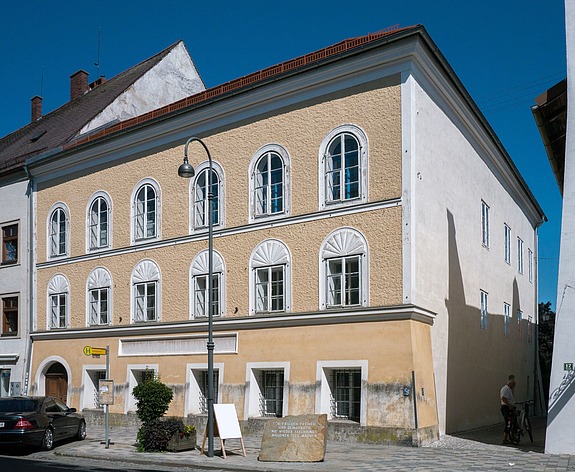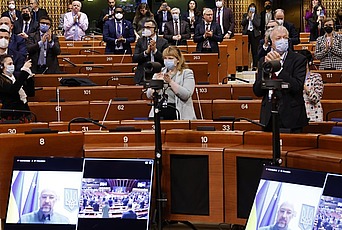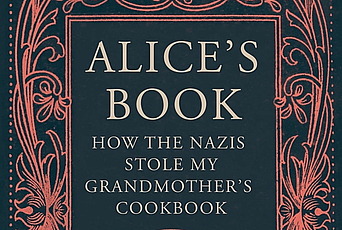Hitler’s Birthplace or: How (Not) to Deal with Uncomfortable Memories

Few people are familiar with the small Austrian town of Braunau near Salzburg. It is here, at Salzburger Vorstadt 15, that Adolf Hitler was born on April 20, 1889; in that home, he spent the first two months of his life. The Third Reich later turned the house into a cultural center. American soldiers prevented it from being blown up in 1945, and it briefly housed an exhibition on concentration camps. After the war, the building served at times as a public library, a bank, a school, and a center for the care and training of people with disabilities. It never gained much significance as a place of pilgrimage for neo-Nazis. On Hitler’s hundredth birthday, the town placed a granite boulder from the Mauthausen camp in front of the house with this inscription:
For Peace, Freedom
and Democracy
Never Again Fascism
Millions of Dead are a Warning
The building was expropriated in 2016 by the Austrian state and has remained unused ever since. It is protected by law as an architectural monument, because its original core dates back to the sixteenth century. In 2019, the Austrian government decided to convert it into the headquarters of the city’s police department, arguing that this would prevent any political exploitation by far-right circles. According to the architectural plans that won a competition, the building is to be restored to the form it was in 1750. The façade is to be painted white, and even the memorial stone from Mauthausen is to be removed. As the president of Austria explained, in a response to my inquiry (September 13, 2021), the city of Braunau supported this decision since “the transformation of the building into a police station would represent a sign of democracy, the representation of human rights, and the fight against racism and antisemitism. Furthermore, it was considered that such a use could best prevent the building from becoming a “place of pilgrimage for neo-Nazis.” This is laudable. But was this decision also influenced by a desire to erase from memory a place that is reminiscent of Austria’s Nazi past? The term used in this context is “Neutralisierung,” translated as “neutralization.” In a response to my inquiry about this decision, the Austrian Chancellor’s Office explained on September 7, 2021 that the Ministry of the Interior decides about the house’s “correct historical use by the Austrian Republic” (die historisch korrekte Nutzung durch die Republik Österreich). How can the elimination of the historical context of a building closely connected with Austria’s modern history be regarded as “correct historical use”?
It is not uncommon that societies prefer collective amnesia to a critical approach to their history. This phenomenon is not directly related to the Roman practice of damnatio memoriae. In the Roman Empire, the names of overthrown emperors were scraped from inscriptions, but the visible traces of the scraping continued to remind the viewers of the condemnation. There are extreme cases of deliberate destruction of uncomfortable material remains of an era. On August 29, 1989, the files that the Greek police authorities kept for people suspected for leftist ideas and activities were burned; the destruction of the files marked the fortieth anniversary of the end of the civil war. Apart from its symbolic significance, it prevented the perpetuation of divisions, since some files revealed that relatives denounced relatives to the police, especially during the dictatorship of 1967–74. Yet such valuable archival material could have been sealed for 50 years, rather than lost to historical research forever.
During World War II, the Royal Palace of the Hohenzollern in Berlin was severely damaged. In 1950, the government of the People’s Republic of Germany used 19 tons of dynamite to demolish what had been left of it. A small part that survived was later incorporated into the “Palace of the Republic” that was built in that location in 1964. It housed the Parliament of East Germany from 1976 to the reunification of Germany in 1990. It was demolished in its turn between 2006–08 and replaced, again, by the completely reconstructed Royal Palace in 2020. While small parts of the notorious wall that once divided Berlin have been kept to remind of the Cold War and its victims, the most emblematic material evidence for the existence of a People’s Republic of Germany disappeared without a trace.
Recently, we saw in the U.S. and other Western countries the destruction of statues of people associated with slavery and colonialism. Statues of Columbus were not spared, and even a monument of Miguel de Cervantes in San Francisco was vandalized in June 2020. (The statue of an author who had been enslaved himself was probably misinterpreted as that of a Spanish conquistador because Don Quixote and Sancho Panza were depicted kneeling in front of Cervantes.) Although the destruction of statues of slave traders and representatives of colonialism is psychologically understandable, it is still the destruction of the material remains of history. Such statues certainly do not deserve a place of honor in public spaces, but could find a home in museums or places where critical memory is cultivated.
The American Journal of Philology, an organ of the Society for Classical Studies, was founded in 1880 by Basil Lanneau Gildersleeve. In 2019, the journal published the following note: “Since 1880, the name of B. L. Gildersleeve has appeared on the cover or title page of every issue of AJP. Starting with this issue, that practice comes to an end.” Gildersleeve was a racist and a supporter of slavery, even after its abolition. The editors acknowledged his contribution to classical studies but also added, “Our intent is not to erase or rewrite history. We take this action because we must stop honoring men such as Gildersleeve, regardless of their considerable professional contributions, as heroes or role models.” This is a constructive way to deal with uncomfortable memories. Personally, I would prefer to see on the journal’s cover the text, “Founded by Basil Lanneau Gildersleeve; the journal’s editors are proud not to follow his views on slavery and racial discrimination.”
Back to the house where Hitler was born. The Austrian government’s decision divided Austrian public opinion. Personalities who promote a critical approach to history, such as the political scientist Andreas Maislinger, proposed the creation of an international ‘House of Responsibility’ in this building, a place of tolerance, reconciliation, and understanding. There, young people from different countries––Japanese and Chinese, Germans and Jews, Turks and Armenians, Americans and Russians, Greeks and Turks––would study the history of their countries, free of the complex of victim and perpetrator, but without ignoring the history of the place. Instead of “neutralizing” a historical space, one would invest it with a new meaning. Who would pay for this? Racism, Hitler nostalgia, and discrimination are not Austrian problems––but rather, European problems. The project of creating a ‘House of Responsibility’ in the very birthplace of the man whose ideas still inspire the worshippers of bigotry in Europe and worldwide can and should become a European project.
After Christianity became the official religion of the Roman Empire, Christians founded churches on the site of ancient shrines. Sometimes the church continued the sanctity of a place, with Saint Panteleimon succeeding Asclepius. Much more often, the aim of Christians was to purify an unholy place, to conquer it for the new religion, to drive out the old demons; the establishment of the church did not mark continuity––but disruption and a new beginning. The “neutralization” of the house where Hitler was born is a missed opportunity for Austrian society to expel a demon of Austrian and European history. The Minister of the Interior chose “neutralization” of history instead of its critical evaluation. However, recently, a group of young female architects (DA - Diskurs Architektur) reopened the discussion: “How to Hitlerhouse?” is the provocative title of their project, a critical debriefing on the building’s transformation and an alternative commission for its future. It remains to be seen if this initiative will succeed in reversing the conscious choice of oblivion.


